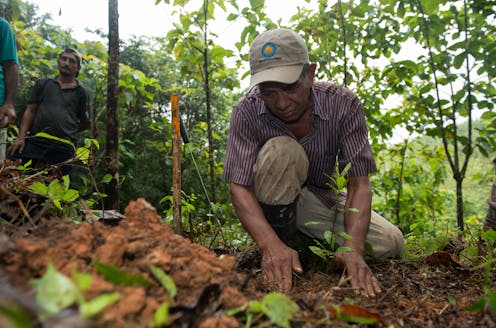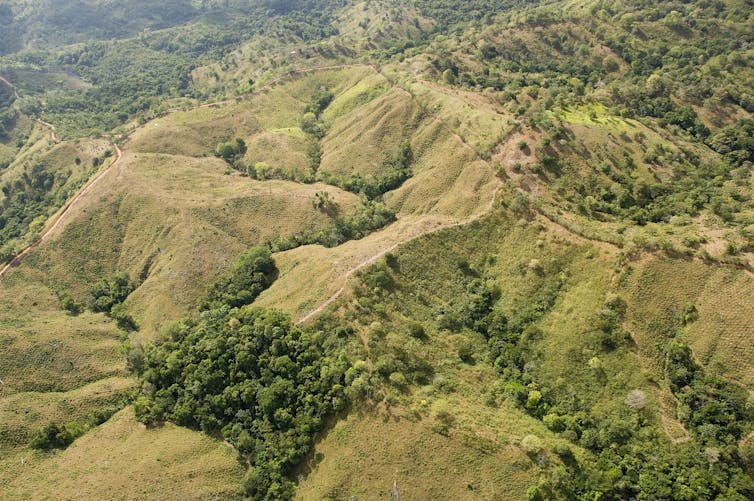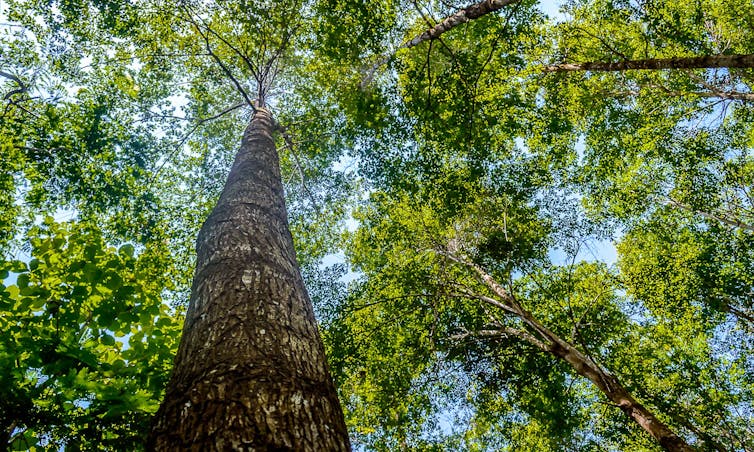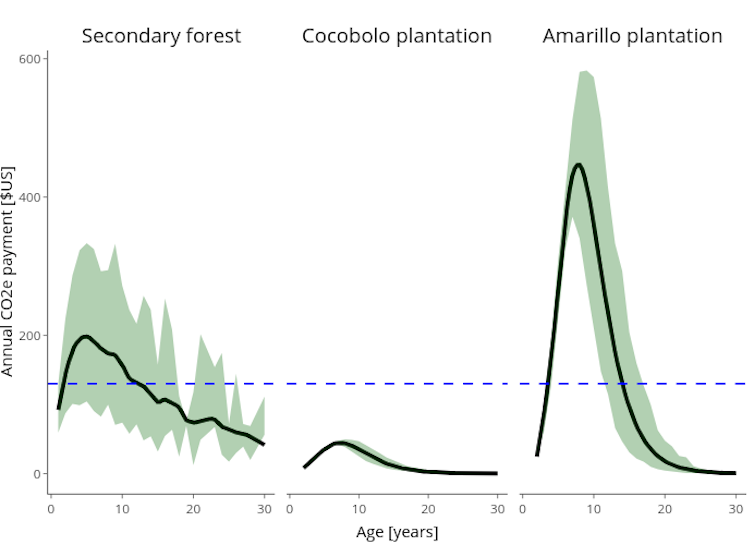
Tropical forest landscapes are home to millions of Indigenous peoples and small-scale farmers. Just about every square meter of land is spoken for, even if claims are not formally recognized by governments.
These local landholders hold the key to a valuable solution as the world tries to slow climate change – restoring deforested tropical landscapes for a healthier future.
Tropical forests are vital to Earth’s climate and biodiversity, but a soccer field-size area of mature tropical forest is burned or cut down about every 5 seconds to clear space for crops and cattle today.
While those trees may be lost, the land still has potential. Tropical forests’ combination of year-round sunshine and high rainfall can lead to high growth rates, suggesting that areas where tropical forests once grew could be valuable sites for reforestation. In fact, a host of international agreements and declarations envision just this.
For reforestation projects to make a dent in climate change, however, they have to work with and for the people who live there.
As forest ecologists involved in tropical forest restoration, we have been studying effective ways to compensate people for the ecosystem services flowing from their land. In a new study, we show how compensation that also allows landholders to harvest and sell some of the trees could provide powerful incentives and ultimately benefit everyone.
The extraordinary value of ecosystem services
Tropical forests are celebrated for their extraordinary biodiversity, with their preservation seen as essential for protecting life on Earth. They are reservoirs of vast carbon stocks, slowing down climate change. However, when tropical forests are cleared and burned, they release copious amounts of carbon dioxide, a greenhouse gas that drives climate change.
Programs offering payments for ecosystem services are designed to help keep those forests and other ecosystems healthy by compensating landholders for goods and services produced by nature that are often taken for granted. For example, forests moderate stream flows and reduce flood risks, support bees and other pollinators that benefit neighboring croplands, and help regulate climate.

In recent years, a cottage industry has grown up around paying people to reforest land for the carbon it can hold. It has been driven in part by corporations and other institutions looking for ways to meet their commitments to cut greenhouse gas emissions by paying projects to reduce or prevent emissions elsewhere.
Early iterations of projects that pay landholders for ecosystem services have been criticized for focusing too much on economic efficiency, sometimes at the expense of social and environmental concerns.
Win-win solutions – where environmental and social concerns are both accounted for – may not be the most economically efficient in the short term, but they can lead to longer-term sustainability as participants feel a sense of pride and responsibility for the project’s success.
That longer-term sustainability is essential for trees’ carbon storage, because many decades of growth is required to build up stored carbon and combat climate change.
Why timber can be a triple win
In the study, we looked at ways to maximize all three priorities – environmental, economic and social benefits – in forest restoration, focusing on infertile land.
It may come as a surprise, but most soils in the tropics are extraordinarily infertile, with concentrations of phosphorus and other essential nutrients an order of magnitude or more lower than in crop-producing areas of the northern hemisphere. This makes restoring tropical forests through reforestation more complex than simply planting trees – these areas also require maintenance.

In our study we used some 1.4 million tree measurements taken over 15 years at the Smithsonian Tropical Research Institute’s Agua Salud site in Panama to project carbon sequestration and potential timber revenues. We looked at naturally regrowing forests, native tree species plantations and an effort to rehabilitate a failed teak plantation by planting high-value native trees known to grow on low-fertility soils to test routes to profitability.
One set of solutions stood out: We found that giving landholders both payments for carbon storage and the ability to generate revenue through timber production on the land could lead to vibrant forests and financial gains for the landholder.
It may seem counterintuitive to suggest timber harvesting when the goal is to restore forests, but allowing landholders to generate timber revenue can give them an incentive to protect and manage planted forests over time.
Regrowing trees on a deforested landscape, whether natural regrowth or plantations, is a net win for climate change, as trees take vast amounts of carbon out of the atmosphere. New forests that are selectively logged or plantations that are harvested in 30 to 80 years can help slow climate change while the world cuts emissions and expands carbon capture technologies.
Reliable payments matter
The structure of the payments is also important. We found that reliable annual carbon payments to rural landlords to regrow forests could match or surpass the income they might otherwise get from clearing land for cattle, thus making the transition to raising trees possible.
When cash payments are based instead on measurements of tree growth, they can vary widely year to year and among planting strategies. With the costs involved, that can stand in the way of effective land management to combat climate change.

Using flat annual payments instead guarantees a stable income and will help encourage more landholders to enroll. We are now using that method in Panama’s Indigenous Ngäbe-Buglé Comarca. The project pays residents to plant and nurture native trees over 20 years.
Shifting risk to buyers of carbon offsets
From a practical perspective, flat annual carbon payments and other cost-sharing strategies to plant trees shift the burden of risk from participants to carbon buyers, often companies in wealthy countries.
The landholders get paid even if actual growth of the trees falls short, and everyone benefits from the ecosystem services provided.
While win-win solutions may not initially appear to be economically efficient, our work helps to illustrate a viable path forward – where environmental, social and economic objectives can be met.
Jefferson S. Hall receives funding from the US government via the Smithsonian Institution, Stanly Motta, Frank and Kristin Levinson, the Hoch family, U-Trust, and the Mark and Rachel Rohr Foundation.
Katherine Sinacore receives funding from the Mark and Rachel Rohr Foundation, Stanly Motta, Frank and Kristin Levinson, the Hoch family, and the Smithsonian.
Michiel van Breugel receives funding from Singapore’s Ministry of Education and the Future Cities Lab Global Program of the ETH-Singapore Centre, which is funded by National Research Foundation Singapore.
This article was originally published on The Conversation. Read the original article.







